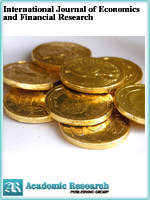International Journal of Economics and Financial Research
Online ISSN: 2411-9407
Print ISSN: 2413-8533
Print ISSN: 2413-8533
Quarterly Published (4 Issues Per Year)

Archives
Volume 3 Number 10 October 2017
Tests of Efficiency in the Foreign Exchange Market
Authors: Ioannis N. Kallianiotis
Pages: 218-239
Abstract
The objective of this paper is to test the efficiency in the foreign exchange market by using four exchange rates ($/€, $/£, C$/$, and ¥/$). Different theoretical models are applied, like the random walk hypothesis, the unbiased forward rate hypothesis, the composite efficiency hypothesis, the semi-strong market efficiency, and the exchange rate expectations based on anticipated and unanticipated events (“News”). If exchange rate efficiency does not hold, a risk premium must exist and can be measured. Also, the determination of this exchange risk premium is taking place by using a GARCH (p, q) model. The empirical results for these four major exchange rates (five currencies) show that relative efficiency exists, but there are significant risk premia for some exchange rates used, here.
Implications of Exchange Rate Fluctuation and Economic Performance: The Nigerian Experience
Authors: Penu, Samuel Lucky ; Nkanbia-Davies, Lilian Okorite
Pages: 206-217
Abstract
The study gauged the influence of exchange rate fluctuations on the Performance of the Nigerian Economy over the time from of 1986 to 2016, utilizing secondary data tracked from the statistical report of the Apex Nigerian bank, and utilizing techniques such as Unit root test, Generalized autoregressive conditional heteroscedasticity (GARCH), Impulse-Response Output and Variance-Decomposition Test to evaluate variables such as Interest rate, inflation rate, exchange rate against a sole indicator of Economic Performance I.e. Gross Domestic Product Growth rate (GDPGR), it was discovered that despite the short run influx of the spill over volatility of Interest rate and inflation rate, there exist no long run volatility influence of interest rate on Economic Performance in Nigeria. It was therefore recommended that the apex financial institution and relevant policy makers should ensure an interest rate system and status that could stimulate growth or production and the nation should endeavour to utilize her interest rate in controlling its output level as it motivates Economic Performance (GDPGR).
Globalization, Trade, and Interdependence
Authors: Hany H. Makhlouf
Pages: 202-205
Abstract
During the course of the second half of the twentieth century, the world economy has become increasingly interdependent as a result of the economic liberalization measures that have been taken by many countries, and the bilateral and multilateral trade promotion and cooperation agreements that have been reached by a majority of trading partners around the world. However, the benefits from the growth in international trade, and economic cooperation and interdependence, have not been shared equally by all nations. Some have benefited more than others, and some have lagged behind due to their inability to compete in a broader and increasingly dynamic global market. This paper examines the impact of economic interdependence from the perspectives of different national groupings, particularly the developed and the least developed countries. One of the questions to be addressed is: What factors contribute to the differences among those nations in taking advantage of open trade and capital mobility? It is expected that this study would be of value to economic planners and to students of international trade and globalization.
Exploiting Uncovered Interest Rate Parity Failure Using Russian Ruble
Authors: Musaed S. AlAli ; Mansour M. AlShamali ; Tariq M. Bin-Ghaith ; Ahmad Y. Bash ; Abdullah M. AlAwadhi
Pages: 197-201
Abstract
The uncovered interest rate parity (UIP) is a parity condition stating that the interest rate differential between two currencies should equal to the expected change in exchange rate between them. But, it has been well documented though that such condition does not stand resulting in an opportunity to benefit from its failure. Traders take advantage of UIP failure by conducting a well-known strategy called carry trade where they borrow low interest rate currencies and invest in high interest rate currencies taking advantage of the interest rate differential and hoping that the movement in exchange rate would not offset it. With interest rate differential being the main components in conducting such strategy for carry traders, Russian ruble offers a very attractive opportunity for such investors. This paper examines the profitability of exploring the failure of UIP using carry trade by borrowing low interest rate currencies which are the U.S. dollar and the Japanese yen and investing in Russian ruble.



